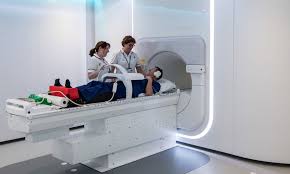Prostate cancer treatment – MR Linac
Consultant Clinical Oncologist
The Royal Marsden
Team Leader Uro radiology research including MR Linac PRISM The Institute of Cancer Research, London

MR Linac treatment for prostate cancer is the most state of the art radiotherapy treatment available
Up until now, radiotherapy for prostate cancer has been directed using scans (usually X-Rays), to try and make sure the radiotherapy treatment is focused on the cancer lesion and avoids the healthy tissues around the prostate, including the rectum. Until the advert of MR Linac, the image guidance for radiotherapy either used small gold seeds placed inside the prostate identified by X – Rays, or performing a CT scan of the prostate daily. Both these methods have drawbacks and inaccuracies due to the changing shape of the prostate, the rectum and the bladder and the clarity of the image. Despite this, the vast majority of men with localised prostate cancer have treatment which cures their cancer, and this is associated with very few side effects in the majority.
The gold standard for viewing the prostate is an MR scan which shows the edge of the prostate much more clearly as well as showing the aggressive cancer lesions within the prostate.
There are two commercially available MR Linac systems, The Viewray MRIdian which incorporates a 0.35T MR scanner and the Elekta Unity MR Linac which integrates a Philips 1.5T MR scanner and an Elekta LINAC. The image quality on the Elekta Unity system is therefore likely to be superior. However, the readily available ‘Gating’ of the treatment using the Accuray MRIdian, means that the beam shuts off when the target moves out of the treatment area by a specified (but completely customisable) amount.
This allows not only exceptional accuracy but also incredible confidence in where the beams are going and what is happening to the target and any organs at risk near enough to be affected.
As well as giving Clinical Oncologists a much clearer picture, it allows them to continuously view the prostate while the patient undergoes treatment. This is important as the Clinical Oncologist can change the radiotherapy plan when they observe changes in the shape and position of the prostate. These changes are mainly due to changes in the rectum which is very dynamic due to rectal filling. Because of this added complexity, a treatment session on the MR-Linac can take longer than usual – around 45 minutes compared to 10 minutes for a standard session, but the dose of radiation that can be delivered is much higher due to the greater accuracy..
All other radiotherapy technologies give the same radiotherapy daily. This means the Clinical Oncologist has to treat a larger ‘safety margin’ around the prostate to allow for these day to day changes in anatomy. A trial, called the PRISM trial, is currently recruiting men with localised prostate cancer and will assess whether treatment on the MR Linac is feasible and acceptable to men.
The first prostate cancer patient was treated with the Elekta Unity MR Linac in September 2018 over 20 sessions at the Royal Marsden Hospital.
MR Linac treatment for prostate cancer is state of the art and heralds a not too distant future where very high doses of radiation can be given in just a few sessions. Treatment could eventually be completed in under a week.

Prostate matters is a not for profit organisation that is committed to providing free expert advice about prostate issues from leading Clinical Authorities
PROSTATE MATTERS
FOLLOW US
Copyright Disclaimer: We try to acknowledge copyright as appropriate. If we have used something without acknowledging copyright, this is inadvertent. Please let us know by emailing info@prostatematters.co.uk



